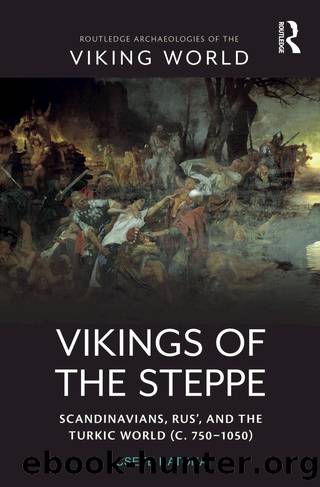Vikings of the Steppe by Csete Katona;

Author:Csete Katona;
Language: eng
Format: epub
Publisher: Taylor & Francis (Unlimited)
Published: 2023-01-15T00:00:00+00:00
Hungary
The possibility of hiring Scandinavian and Rusâ bodyguards has also been proposed in the case of Hungary, a theory less well known in Western historiography. As early as the 1950s, noted Hungarian medievalist György Györffy asserted that âVarangian-Rusâ mercenariesâ were in the service of Grand Prince Géza and the first king, Saint Stephen I, from the end of the tenth century onwards (Györffy 1959, 86â92, 1984, 831â32; [1977] 2013, 313â14). Even though his hypothesis was questioned by Gyula Kristó (another famous Hungarian medievalist and contemporary of Györffy) on chronological and linguistic grounds (Kristó 1983), the thesis is still popular in scholarly circles (for references, see Katona 2017a).
According to this theory, âVarangian-Rusââ bodyguards were present in Hungary in the 980s CE, near the end of Gézaâs reign, when the Pechenegs were becoming a serious threat on the Dnieper waterways. This prompted the Rusâ to march from Kiev to Constantinople (and back) through the Magyar territories, which were believed to be more friendly, and some of them entered Gézaâs service (Györffy 1959, 92). Migrating Rusâ bodyguards could have come to Hungary in larger numbers with time since, according to the PVL, Stephen (who followed Géza on the throne) maintained good relations with Grand Prince Vladimir of Kiev (Cross and Sherbowitz-Wetzor 1953, 122; Likhachev 1996, 56). The presence of Magyar warriors in Vladimirâs court is supported by archaeological material from the so-called druzhina-graves (Tagán 1941; Borosy 1981, 34; Fodor 2007, 193â99). Besides the bodyguard exchange between the Kievan and the Hungarian courts, a wave of âVarangiansâ arrived in Hungary with the Byzantine fiancée proposed for Stephenâs son, Emeric (Moravcsik 1938; Györffy 1959, 92; Makk 1999, 37). Since Emeric is labelled as dux Ruizorum, that is, âPrince of the Rusâ â, in the contemporary Annales Hildesheimenses in the year 1031 CE (Waitz 1878, 36), Györffy claimed that he was the leader of the royal bodyguard, as traditionally the heir to the throne commanded the foreign auxiliaries. The âVarangiansâ escorting Emericâs fiancée from Byzantium could have been settled near the central territories of the kingdom, in Tolna and Somogy counties, where the name of two settlements, Várong and Varang, seem to have an Old Norse root â væring (meaning âa companion who takes an oathâ). In contrast, retinue members arriving from Kiev might have come to reside not far from the contemporary frontiers, as is suggested by settlement names with the Hungarian stem orosz, originating from the word Rusâ. The secondary meaning of orosz, âbodyguardâ or âdoorkeeperâ, strengthens this point (Györffy 1959, 83â92, 1966â98: I, 126, 464â65, III, 365â66, IV, 169â71), although Kristó argued that this meaning did not appear before the sixteenth century (Kristó 1983, 199â201). The Varangian-Rusâ bodyguard in Hungary was paralleled with analogous institutions in Kiev, Poland and Byzantium (Györffy 1959, 87â92, [1977] 2013, 108, 313, 417).
Although the evidence for this theory accumulated incoherently (Katona 2017a), we should still entertain the possibility that some Scandinavians and Rusâ indeed took service in Hungary. The evidence can be best synthesized by assuming that the
Download
This site does not store any files on its server. We only index and link to content provided by other sites. Please contact the content providers to delete copyright contents if any and email us, we'll remove relevant links or contents immediately.
| General | Copenhagen |
Room 212 by Kate Stewart(4721)
The Crown by Robert Lacey(4561)
Endurance: Shackleton's Incredible Voyage by Alfred Lansing(4479)
The Iron Duke by The Iron Duke(4105)
The Rape of Nanking by Iris Chang(4007)
Killing England by Bill O'Reilly(3893)
Joan of Arc by Mary Gordon(3770)
Say Nothing by Patrick Radden Keefe(3709)
I'll Give You the Sun by Jandy Nelson(3257)
Shadow of Night by Deborah Harkness(3164)
Hitler's Monsters by Eric Kurlander(3149)
Blood and Sand by Alex Von Tunzelmann(3046)
Mary, Queen of Scots, and the Murder of Lord Darnley by Alison Weir(3043)
Darkest Hour by Anthony McCarten(3011)
Margaret Thatcher: The Autobiography by Thatcher Margaret(2965)
Eleanor & Park by Rainbow Rowell(2929)
Red Famine: Stalin's War on Ukraine by Anne Applebaum(2807)
Book of Life by Deborah Harkness(2709)
The One Memory of Flora Banks by Emily Barr(2678)
